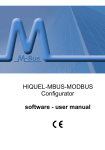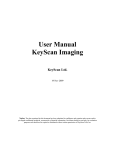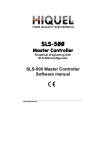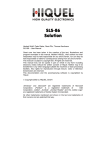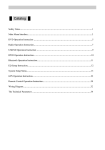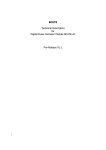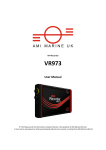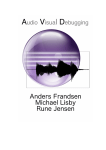Download Content - Hiquel
Transcript
HIQUEL-TERM4 The universal alphanumeric text display BESTELL NR: TERM4-MAN-D-10 HIQUEL HIQUEL-TERM4 HIQUEL-TERM4: User’s manual Order number: TERM4-MAN-D-10 Version: 1.00 Great care has been taken in the creation of the text, illustrations and program examples in this manual. Neither HIQUEL, their authors nor their interpreters may be held responsible for any errors herein, nor can they be held responsible or liable for consequences arising from any errors herein. This manual is subject to copyright law. All rights are reserved. This manual may not be copied in part or whole in any form including electronic media without the written consent of Hiquel. Neither may it be transferred in any other language suitable for machines or data processing facilities. Also rights for reproduction through lecture, radio or television transmission are reserved. This documentation and the accompanying software is copyrighted by Hiquel. Copyright 1998 by Herbert Weiß 2 HIQUEL HIQUEL-TERM4 Content CONTENT 3 PREFACE 5 Guide PRODUCT DESCRIPTION HIQUEL-TERM4 SETTINGS 5 6 6 8 Setup of HIQUEL-TERM4 8 Reset the unit 9 OPERATIONS 10 Operation elements 10 Keyboard 10 Messages 11 Input fields 11 Menu 12 ASCII-MODE 14 Sending text 14 Interpreting special symbols 14 Escape sequences 14 Print Hex as ASCII 14 Get information 15 Position XY 16 Delete screen 16 Home cursor 16 Evaluate keystrokes 16 Key codes 18 Define minimum 19 3 HIQUEL Define maximum HIQUEL-TERM4 19 Input number 20 Abort input 21 Redraw 21 Define character 22 Beep 22 PROTECTED MODE 23 TYPE=0x01 Clear screen 24 TYPE=0x10 Write line 25 TYPE=0x20 Beep 25 TYPE=0x80 Check keys 26 TYPE=0x90 Input 27 TYPE=0x91 Get input 28 TYPE=0x92 Abort input 28 TYPE=0xF0 Define character 29 CHARACTERS 30 TECHNICAL INFORMATION 31 MODULE JACK-socket ADDITIONAL COMPONENTS 31 34 4 HIQUEL HIQUEL-TERM4 Preface Thank you for purchasing our text display HIQUEL-TERM4. Please read all instructions carefully before operation, to ensure your complete understanding and to obtain the best possible performance from the terminal. Guide The User’s manual is devided into four parts: The chapter Product Description deals with basic informations about the HIQUEL-TERM4. The chapter Settings describes the operation of the setup menu and the adjustment of various parameters. The chapter Operations refers to the handling of the terminal. The chapter ASCII-Mode defines settings for connecting separate devices with our terminal HIQUEL-TERM4. 5 HIQUEL HIQUEL-TERM4 Product Description HIQUEL-TERM4 is designed to operate and monitor control systems. e.g.: SIMATIC S5, or SIMATIC S7 etc. The compact, robust housing features a 4 line LC display, each line having 20 characters. A keypad with 9 overlay keys is also featured. Each key has a unique symbol. Typical applications for this terminal are alarm monitoring, parameter display and edit menu structures and message display. Refer to the chapter ASCII-Mode to discover how HIQUEL-TERM4 is also able to communicate with data on your host system. HIQUELHIQUEL-TERM4 6 HIQUEL HIQUEL-TERM4 Display Tastaturfeld Anschluß HIQUEL-TERM4 is a very compact device. On the front you will find the alphanumeric display and the keypad. On the rear you will find a 6-pole modular socket for connecting the HIQUEL-TERM4 with the host system. Display The alphanumeric display contains a backlit LC-display with 4 lines and 20 characters each line. The character’s height is 5mm. Keypad The text display is operated by using the softkeys, which use special symbols to make the operation easier. Connnection The terminal is supplied with 24VDC via the 6-pole modular socket. The socket also connects the host system via RS232 interface with the terminal. Size The terminal is 125mm wide, 108mm high and 22mm deep. The device is designed for front panel mounting but can also be used as a stand-alone-device. 7 HIQUEL HIQUEL-TERM4 Settings You can adjust various functions of the HIQUEL-TERM4 with the setup menu. SETUP of HIQUELHIQUEL-TERM4 To get into the SETUP menu, switch off the device first. Afterwards press the keys , and SIMULTANEOUSLY. Now switch on the device again. After this you will see the following menu for about 5 sec.: Contrast: 50% Busnumber: 0 Baudrate: 19200 8N1 CommMode: ASCII The setting which is active and ready to be changed is flashing. To choose another setting to adjust, use the buttons: . To adjust a setting use the keys: changed settings press saving press Contrast and and . For saving all . Setup will be closed. To exit without . The first setting is the LC-display contrast. Adjust the display with and appear. . The higher the contrast, the darker the display will 8 HIQUEL HIQUEL-TERM4 Busnumber If you want to connect more than one terminal with the bus of Hiquel-Term4 during the protected mode, you can adjust bus numbers for the individual terminals with and 255. Baudrate and between 0 Here you can adjust the serial communication format and speed. Use and . You can choose the following settings: Setting Baudrate 4800 8N1 4800 8E1 4800 8O1 9600 8N1 9600 8E1 9600 8O1 19200 8N1 19200 8E1 19200 8O1 4800Bd 4800Bd 4800Bd 9600Bd 9600Bd 9600Bd 19200Bd 19200Bd 19200Bd Data Bits 8 8 8 8 8 8 8 8 8 Parity Stop Bits Non Straight Not straight Non Straight Not straight Non Straight Not straight 1 1 1 1 1 1 1 1 1 Comm mode With the keys and you can choose different logs of the Hiquel-Term4. The setting ASCII indicates the unprotected ASCII-log. The setting Protected indicates the protected, bus – ready mode of the Hiquel-Term4. Reset the unit If the device locks up, you can reset it by disconnecting the supply voltage of HIQUEL-TERM4 first and pressing , and and then re-connecting the supply with the buttons pressed. The usual welcome message will appear after a short period of time. Now you can release the keys. All previously adjusted settings are overwritten and reset. 9 HIQUEL HIQUEL-TERM4 Operations This chapter defines the operation of the several components, if you use the HIQUEL-TERM4 together with the compact control unit RESI-M. This chapter could also be considered as a Design Guide, other host systems like SPS (PLC’s) or PC’s should follow this example. Operation elements Messages Input fields Menu Keyboard This key confirms an input positiv. Every number input, menu choice or dialog is confirmed positiv and saved by pressing this key. This key aborts a running input of numbers, a menu choice or a dialog adjustment. With these keys you can change numbers or change your menu choice. Jump into the next input field by pressing this key. 10 HIQUEL HIQUEL-TERM4 Messages Messages are static text displays, which inform about a failure or show a result. Example: MESSAGE This is current status information If you want to confirm the message and continue with the program, press . With some messages, it’s possible to abort a running action and to get one step back. For this use Example: . START MEASUREMENT Would you like measurement to start? Input fields To acquire numbers, HIQUEL-TERM4 uses a very simple type-inmethod. In front of the changeable number you will see a thick, flashing right-hand arrow. Now you can adjust the number with the up and down or abort with keys. Save the number by pressing in order to restore the previous value. To get to the next input field (if it’s existing) press . 11 HIQUEL HIQUEL-TERM4 Example: Temperature set value New Value: 099.5°C Menu The menu offers you the possibility to choose different settings, to adjust them or execute several functions. Every menu has the same structure: Main menu Point measurement curve measurement Settings A thick, flashing right-hand arrow appears. This arrow marks the and down active setting in the menu. By pressing the up keys you can choose another setting in the menu. If more menu-entries than lines exist, the text will scroll so that the remaining lines can be viewed. 12 HIQUEL HIQUEL-TERM4 Having made your choice, you can confirm by pressing want to abort, press . If you . If there are several menu settings, you can choose your setting by using . Example: PRINTER CONFIGURATION Printer ON Type BOLD Language English 13 HIQUEL HIQUEL-TERM4 ASCII-Mode During the ASCII-mode the terminal accepts all ASCII-characters that are transmitted over the serial port. The terminal will show them immediately on the display. With special escape sequences you can operate complex functions like cursor positioning or delete screen. You can execute special functions with the following characters. Sending text The terminal receives the usual ASCII-characters during the ACIImode. The chapter CHARACTERS deals with all available characters on the display. Interpreting special symbols 0x0d Carriage Return 0x0a Line Feed 0x08 Backspace @@ brings out an @ Escape sequences For special functions like cursor positioning or clear screen, you have to send an escape sequence first. The terminal interprets this function not as characters to display but as parameters for the respective function. The escape character is always ´@´. Print Hex as ASCII As protocols of several host systems do not tolerate the transfer of ASCII codes under 32 or over 127 using a serial port, an 14 HIQUEL HIQUEL-TERM4 escape sequence was developed that creates the opportunity to display all ASCII characters which are outside this range. @x[HH] This escape sequence creates every character on the display. The code [HH] indicates that the created character is hexidecimal. You can use the numbers ´0´-´9´ and the capital letters ´A´-´F´. Get Information With this command you can check the active software version of HIQUEL-TERM4. To get the information, transfer to HIQUEL-TERM4: @I You will receive the following response from HIQUEL-TERM4: @i[Information] [Information] zero determinated ASCII string, which supplies the information from the terminal. 15 HIQUEL HIQUEL-TERM4 Position XY You can put the cursor on any position on the display that you like with this command. You just have to transfer the following code: To HIQUEL-TERM4: @P[X][Y] [X] indicates the X-position on the display, ASCII-‘A’ (65, 0x41) stands for the first column, ASCII-‘B’ (66, 0x42) for the second, etc. The largest used character is ASCII-‘T’ (85,0x55) [Y] indicates the Y-position on the display, ASCII-‘A’ (65, 0x41) stands for the first column, ASCII-‘B’ (66, 0x42) for the second etc. The largest used character is ASCII-‘T’ (85,0x55) The terminal does not respond to these commands. Delete Screen This command clears the active display and sets the cursor at the left-hand upper corner of the display. To HIQUEL-TERM4: @D The terminal does not respond to this command. Home Cursor This command sets the cursor at position 1,1. The entire display remains maintained. To HIQUEL-TERM4: @H The terminal does not respond to this command. Evaluate Keystrokes While using the ASCII-Mode, the user can choose between two methods of evaluating keystrokes: 16 HIQUEL HIQUEL-TERM4 Signal edge triggering Condition triggering These modes can be changes to elapse time, that way the utmost flexibility in the user interface is possible. You can activate the signal edge evaluation with the following command: To HIQUEL-TERM4: @E1 Response: non Using signal edge triggering, the HIQUEL terminal transfers one character when pressing the key and a second when releasing the key. That way both edges can be used. You can activate the normal keystroke triggering with the following command: To HIQUEL-TERM4: @E0 Response: non The terminal will only transfer a character when pressing the key. As all keys have an autorepeat function, in this mode the character will be repeated as long as the user presses the corresponding key. 17 HIQUEL HIQUEL-TERM4 Key codes The nine keys are grouped in a 3x3 matrix. The HIQUEL-TERM4 transfers signals after every pressed key. Using the normal keystroke triggering mode the following codes are transmitted: A B C D E F G H I Using the signal edge triggering mode the following codes are transmitted: A B C D E F G H I 18 HIQUEL HIQUEL-TERM4 Releasing the keys, following codes are transmitted: a b c d e f g h i Define Minimum With the following characters you can define the minimum for the input. This minimum is used as the bottom limit for all following inputs. To HIQUEL-TERM4: @<[MIN] The terminal does not respond to this command. Define Maximum With the following characters you can define the maximum for the input. This maximum is used as the uppermost limit for all following inputs. To HIQUEL-TERM4: @>[MAX] The terminal does not respond to this command. 19 HIQUEL HIQUEL-TERM4 Input Number You can define the number format with the following characters: To HIQUEL-TERM4: @N[L][K][DEF] The terminal does not respond to this command. The transfer parameters have the following meaning: [L] indicates the length of the input (max 20 characters) The number has to be transfered as a capital letter between ‘A’ and ‘T’. [K] indicates the amount of decimal places. The number has to be transfered as a capital letter between ‘A’ and ‘T’. Letter ‘A’ indicates no decimal place, letter ‘B’ indicates one decimal place, and so on. [DEF] indicates the default value (initial value) of the input (32 Bit). The number has to be transmitted as a 8-digit hexidecimal number. Only the characters ‘0’-‘9’ and ‘A’-‘F’ can be used. The input will be started at the right-hand side of the active cursor position. After the input the cursor is located behind the input field. That means [L]+1 character to the right of its initial position. Example: @NEB000001FE indicates: length 5, 2 decimal places and default value 510. After this command, the cursor will be set behind the last character. To change the number value, use the up and down keys. Response: If the input is confirmed by pressing , the following protocol will be transmitted: @n[VAL] [VAL] indicates the active number value as a 8-digit hexidecimal number . A range from -231 ( 8000000 sedez. ) to +231 ( 7FFFFFFF ) can be displayed. If you end your input by pressing will be transmitted: @b , the following protocol 20 HIQUEL HIQUEL-TERM4 Abort Input You can abort your input with the following characters: To HIQUEL-TERM4: @n The terminal does not respond to this command. Redraw Response: @r These characters of HIQUEL-TERM4 signal a failure of the display or a failure during the transfer. A new input is required. 21 HIQUEL HIQUEL-TERM4 Define Character To HIQUEL-TERM4: @C[CHAR][BITMAP] [CHAR] indicates the ASCII-Code of the new character. You can use numbers from 0 to 7. [BITMAP] 8-digit hexidecimal numbers will be transmitted, each number defines one segment of a character. Example: @C00001010202120C04 To define the character press . HIQUEL-TERM4 responds with the following protocol: @c If defining the character was successful it will be saved after switch off. Beep With this command you will activate the integrated audible Beep (only available with version HIQUEL-TERM4B). To HIQUEL-TERM4B: @B[DURATION] [DURATION] Duration of the peep indicated in units of 3/100s. The terminal does not respond to this command. 22 HIQUEL HIQUEL-TERM4 Protected Mode The protected mode is a communication form containing identification of transfer failures. By using defined data packages and control sums this mode guarantees the correct display content. Due to failures, errors can be detected and the appropriate correction can be made. This protocol is protected against failures due to mechanical components and electric current. The following frames are used for the transmission: Type Bytes Description HEADER 2 STATIONS ID (SID) 1 Identification for strarting a frame (characters ´T´ ´D´) Address of the receiver (0 to 255) ; Receiver = Terminal TYPE DATALENGTH (LEN) 1 1 Function type Length of the data block indicated in bytes (max 21 bytes); terminal operates line by line HCRC 1 Check sum for Header DATA DCRC xx 1 xx is DATALENGTH . xx bytes will follow Check sum for data The Header activates a new log frame. It’s fixed and consists of the characters ´T´ and ´D´. The bus address STATION ID describes the active station (the active terminal). You can adjust the STATION ID in the setup (menu – busnumber). You have to place a number between 0 and 255 for every component. DATALENGTH describes the length of the data block in bytes (max 21 bytes). If the value 0 appears as DATALENGTH, DATA and the check sum will be ignored. 23 HIQUEL HIQUEL-TERM4 The check sum HCRC calculates: HCRC = STATION ID XOR TYPE XOR DATALENGTH Check sum CRC2 calculates as follows: DCRC = D0 XOR D0 XOR D0 ...... XOR Ddatalength -1 Dx describes the x-byte of the data block. TYPE=0x01 Clear Screen With this protocol you are able to delete the entire content of the display. Transfered protocol to the terminal: ´TD´ SID 0x01 0x00 HCRC If the transmission is successful, the terminal will response with the ACKNOWLEDGE protocol: ´TD´ SID 0x00 0x00 HCRC 24 HIQUEL HIQUEL-TERM4 TYPE=0x10 Write Line This protocol writes the transmitted characters into the first line of the display. Transfered protocol to the terminal: ´TD´ SID 0x10 LEN HCRC POSITION DATA DCRC The display will show the characters which are indicated in DATA, to the position POSITION. POSITION specifies a fixed position on the display. The value POSITION is calculated as follows: POSITION=Y-position*20+X-position; X-position and Y-position start with 0 (max 20 characters). If the transmission is successful, the terminal will respond with the ACKNOWLEDGE protocol: ´TD´ SID 0x00 0x00 HCRC TYPE=0x20 Beep This protocol delivers a audible signal of HIQUEL terminal (only availabe with version HIQUEL-TERM4B). Transfered protocol to the HIQUEL terminal: ´TD´ SID 0x20 0x01 HCRC DURATION DCRC The parameter DURATION defines the duration of the peep indicated in units ot 3/10 s. The ACKNOWLEDGE protocol will be the response: ´TD´ SID 0x00 0x00 HCRC 25 HIQUEL HIQUEL-TERM4 TYPE=0x80 Check Keys This protocol checks the keyboard inputs of the HIQUEL terminal. Transfered protocol to the HIQUEL terminal: ´TD´ SID 0x80 0x00 HCRC The ACKNOWLEDGE protocol will be the response: ´TD´ SID 0x81 0x02 HCRC STATUS DCRC The returned parameters from the HIQUEL terminal indicate: STATUS (16-bit) This 16-bit word defines the bits 0..8 for the status of a key (1=key pressed, 0=key not pressed). The word is transmitted with the lowest byte first. The keys refer to the following bit numbers: 0 1 2 3 4 5 6 7 8 26 HIQUEL HIQUEL-TERM4 TYPE=0x90 Input This protocol starts the input at the terminal. The parameters indicate the position of the cursor during the input, the length of the input, the decimal places, the maximum value and the default value. Protocol to the terminal: ´TD´ SID 0x90 0x10 HCRC X Y LEN CO MIN MAX DEF DCRC The returned parameters from the HIQUEL terminal indicate: X 8-bit X-position on the display, value between 0 and 19 Y 8-bit Y-position on the display, value between 0 and 3 LEN 8-bit length of the input CO 8-bit number of decimal places MIN 32-bit signed minimum value of the input MAX 32-bit signed maximum value of the input DEF 32-bit signed standard value of the input If the terminal has received the protocol correctly, the number input at the desired position will be active and the terminal will respond as follows: ´TD´ SID 0x00 0x00 HCRC 27 HIQUEL HIQUEL-TERM4 TYPE=0x91 Get Input With this protocol you can get the latest status of the input from the terminal. Transfer the following protocol to the terminal: ´TD´ SID 0x91 0x00 HCRC The terminal will respond: ´TD´ SID 0x92 0x05 HCRC STATUS VALUE DCRC STATUS VALUE TYPE=0x92 8-bit status of the input 00 input ended with OK 01 processing 02 input cancelled 32-bit signed response value of the input Abort Input You can cancel the active input at the terminal with this protocol. Transfer the following characters to the terminal: ´TD´ SID 0x92 0x00 HCRC If the terminal has not received the protocol, the input will be cancelled and the terminal will respond as follows: ´TD´ SID 0x00 0x00 HCRC 28 HIQUEL HIQUEL-TERM4 TYPE=0xF0 Define Character You can create one new character by using this protocol. There are 8 characters which can be changed. Transfered protocol to the HIQUEL terminal: ´TD´ SID 0xF0 0x09 HCRC CHAR BITMAP DCRC The parameter CHAR defines the to be changed character. Values between 0x00 and 0x07 are allowed. The parameter BITMAP defines 8 bytes but just the lowest 5 bits are valid. These seven bytes define the new character. If the transfer is successful, the terminal will respond with the ACKNOWLEDGE protocol: ´TD´ SID 0x00 0x00 HCRC If defining the character was successful it will be saved beyond swich off. 29 HIQUEL HIQUEL-TERM4 Characters The following HIQUEL-TERM4 characters are available after purchasing: 0x00 0x20 0x30 0x40 0x50 0x60 0x70 0xA0 0xB0 0xC0 0xD0 0xE0 0xF0 0x01 0x21 0x31 0x41 0x51 0x61 0x71 0xA1 0xB1 0xC1 0xD1 0xE1 0xF1 0x02 0x22 0x32 0x42 0x52 0x62 0x72 0xA2 0xB2 0xC2 0xD2 0xE2 0xF2 0x03 0x23 0x33 0x43 0x53 0x63 0x73 0xA3 0xB3 0xC3 0xD3 0xE3 0xF3 0x04 0x24 0x34 0x44 0x54 0x64 0x74 0xA4 0xB4 0xC4 0xD4 0xE4 0xF4 0x05 0x25 0x35 0x45 0x55 0x65 0x75 0xA5 0xB5 0xC5 0xD5 0xE5 0xF5 0x06 0x26 0x36 0x46 0x56 0x66 0x76 0xA6 0xB6 0xC6 0xD6 0xE6 0xF6 0x07 0x27 0x37 0x47 0x57 0x67 0x77 0xA7 0xB7 0xC7 0xD7 0xE7 0xF7 0x08 0x28 0x38 0x48 0x58 0x68 0x78 0xA8 0xB8 0xC8 0xD8 0xE8 0xF8 0x09 0x29 0x39 0x49 0x59 0x69 0x79 0xA9 0xB9 0xC9 0xD9 0xE9 0xF9 0x0A 0x2A 0x3A 0x4A 0x5A 0x6A 0x7A 0xAA 0xBA 0xCA 0xDA 0xEA 0xFA 0x0B 0x2B 0x3B 0x4B 0x5B 0x6B 0x7B 0xAB 0xBB 0xCB 0xDB 0xEB 0xFB 0x0C 0x2C 0x3C 0x4C 0x5C 0x6C 0x7C 0xAC 0xBC 0xCC 0xDC 0xEC 0xFC 0x0D 0x2D 0x3D 0x4D 0x5D 0x6D 0x7D 0xAD 0xBD 0xCD 0xDD 0xED 0xFD 0x0E 0x2E 0x3E 0x4E 0x5E 0x6E 0x7E 0xAE 0xBE 0xCE 0xDE 0xEE 0xFE 0x0F 0x2F 0x3F 0x4F 0x5F 0x6F 0x7F 0xAF 0xBF 0xCF 0xDF 0xEF 0xFF 30 HIQUEL HIQUEL-TERM4 Technical information The following chapter gives you detailed technical information about the HIQUEL-TERM4 devices. MODULAR JACK-socket On the rear of the Term4 you will find the 6 pole MODULAR JACK-socket with the following signals: ATTENTION: Always use original HIQUEL-TERM4 cable for connecting the terminal with your host system. TERM4-Pin Signal Description 1 pink +24V Zoom voltage supply +24VDC 2 grey GND Voltage Supply Ground 3 yellow DI Digital erase input (+24V) 4 green GND RS232-Interface Ground 5 brown RXD RS232-Interface Receive Data 6 white TXD RS232-Interface Transmit Data 31 HIQUEL HIQUEL-TERM4 You have to use the following cabel if you want to operate with devices which contain a 9 pole standard DSUB hub in order to communicate via RS232: TERM4 Signal DSUB Pin Signal Pin 1 pink +24V +24V 2 grey GND GND 3 yellow DI DI 4 green GND Connect with 5 GND 5 brown RXD Connect with 3 TXD 6 white TXD Connect with 2 RXD All other pins of the DSUB hub remain empty. Of course you have to connect a supply voltage (+24VDC) with TERM4 pins 1 and 2. 32 HIQUEL HIQUEL-TERM4 Fig: Measurements for HIQUEL-TERM4 33 HIQUEL HIQUEL-TERM4 Additional components You can order the following products: TERM4-MAN-D: User’s manual for programming HIQUEL-TERM4 or HIQUEL-TERM4B in German. TERM4-MAN-E: User’s manual for programming HIQUEL-TERM4 or HIQUEL-TERM4B in English. TERM4-CONN: Connection cable for HIQUEL-TERM4 with a host system (open end). HIQUELHIQUEL-TERM4: TERM4 Standard universal text display. HIQUELHIQUEL-TERM4B: TERM4B Extended universal text display with buzzer and cyrillic font. HIQUEL GesmbH. Bairisch Kölldorf 266, A-8344 Bad Gleichenberg, Austria Tel: ++43-(0) 3159-3001 Fax: ++43-(0)3159-3001-4 e-mail: [email protected] http://www.hiquel.com 34


































